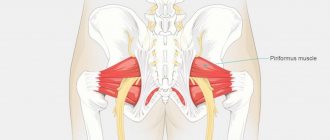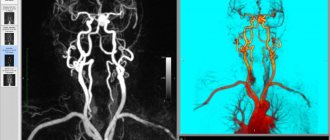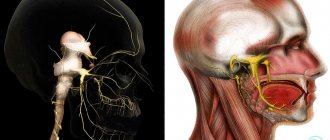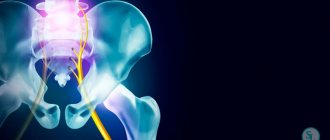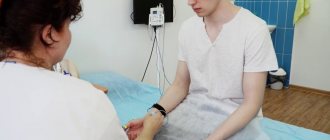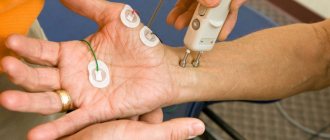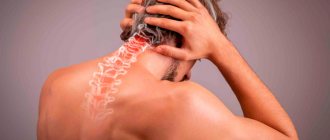General information
Lasegue's symptom from the group of violations of the tension of the roots is also called “pathology of straight leg raising” and is characteristic of neuropathy of the femoral nerve and spinal roots, Guillain-Barr syndrome , etc.
The symptom is named after the French physician Ernest Charles Lasegue, famous for lecturing on the mentally ill in Paris in the 19th century. Being a representative of traditional medicine, he preferred the observational technique of treating patients over the experimental one. The symptom he discovered plays a very important diagnostic role in neurology.
Diagram of the connection between the sciatic nerve and the spinal cord
Method for identifying Lasegue's symptom
During the examination, the doctor places the patient on his back on the couch and begins to smoothly lift the subject's leg, bending it at the hip joint and holding the knee. The leg is raised to a maximum of 90° or until pain occurs along the sciatic nerve. At this stage, it is important that the patient clearly determines at what angle the pain occurs. The true Lasegue symptom in neurology is an important indicator for tracking the dynamics of the disease.
At the next stage, the medical worker must bend the leg at the knee and if the pain stops, then Lasegue’s symptom is considered positive; when returning to the starting position - straightening the leg, the pain should resume. Otherwise - if the acute pain has not stopped, then the origin of the pain is different - it is not caused by the tension of the affected spinal root.
When does a positive Lasègue symptom occur?
In neurology, this phenomenon belongs to the group of so-called tension symptoms; from the name it is clear that the formation of this diagnostic sign is associated with tension and tension of the nerve trunk.
- The most common case when a positive Lasègue symptom is observed is with osteochondrosis. Inflammation in the area of the nerve root leads to its compression and tension. Other symptoms of this group (Nery, Bekhterev) will also be positive.
- Acute discogenic lumbodynia. This condition occurs when the fibrous ring is torn, leading to protrusion of the intervertebral disc in the spinal disc segment. The cause of such a violation may be awkward movement in the lumbar spine, sudden lifting of weight. Clinically, acute discogenic lumbodynia is manifested by sharp pain in the lumbar region, often causing the patient to “freeze” in the position in which the pain syndrome found him. The duration of a painful attack is from half an hour to several hours. When diagnosing, an important role is played by the symptoms of Matskevich and Lasègue, the “board” symptom (impossibility of flexion in the lumbar region).
- Subacute discogenic lumbodynia. The reason is prolonged physical activity in a position that is uncomfortable for the patient (often in a bent state). Unlike the acute condition, subacute lumbodynia is characterized by a delayed development of pain.
Pathogenesis
The so-called “position” and “tension” symptoms are based on myofixation of the affected movable segment - reflexive or subconscious, which occurs as a result of irritation of the receptors present in the deformed tissues. This may increase intradiscal pressure. Normally, nerves have a reserve of length, although limited. They are able to move in relation to nearby tissues in the fascial bed, so there is almost no tension on the nerve. However, if for one reason or another pathological changes develop in nearby structures - their fibrous growth, deformation - then this can lead to excessive overstretching of the nerve.
When lifting a leg in people, depending on the angle (usually 70-90°), pain occurs in the lumbosacral region and the back surface of the limb, more often in the area of the lower leg, popliteal fossa, thighs and buttocks, because they act in such a situation as one whole, while the lumbar lordosis is straightened, the iliopsoas muscles are activated, the remaining parts of the spine are brought closer together, which causes injury to the affected tissues or excessive tension of the sciatic nerve roots.
Lasègue test
The symptom was first discovered by the French neurologist Lasegue back in the mid-19th century. He conducted an experiment in which he discovered a sharp pain in a patient when raising a straight leg in a supine position; after bending the knee or hip joint, the painful sensations stopped instantly.
Pain when raising the lower limb in a straight position occurs due to stretching of the sciatic nerve, while the pain reaction can be caused by tension in only one nerve root. A painful reaction occurs due to compression of the nerve roots in the intervertebral foramen due to its excessive tension.
Normally, stretching of the nerve as part of a physiological process cannot cause its overstrain, and movement in the intervertebral foramen occurs smoothly, the root easily slides along it without excessive compression. Painful sensations may occur due to the fact that the nerve fibers of the sciatic nerve are not able to lengthen naturally, this may be due to pinching or overstretching.
The sciatic nerve is the largest nerve in the human body and positive Lasegue syndrome can indicate a number of diseases along its length. Doctors use the symptom of tension to make an accurate diagnosis of diseases of the lumbosacral spine.
Classification
Depending on the severity of the manifestations, the positive Lasegue symptom is of 3 types:
- the first type - which is characterized by a mild manifestation of low-intensity pain that occurs when the patient raises his leg no higher than an angle of 60°, and a protective reaction occurs in the form of a moderate contraction of the muscles of the back and pelvis, as well as the abdominal wall;
- the second type is characterized by moderately severe pain when lifting the leg at an angle of no more than 45°, which causes a moderate autonomic reaction and protective contraction of individual muscle groups;
- the third type is manifested by pronounced pain when lifting the leg at an angle of up to 30° against the background of generalized protective muscle contractions and a sharp autonomic reaction; such a disorder is considered articular, since when lifting by so many degrees, tension on the root does not occur.
Determination of the leg elevation angle when testing for Lasegue's symptom
Important! Elderly people with weak hamstring muscles may experience a pseudo-positive Lasegue sign, which usually manifests itself as soreness in the thigh muscles.
Modification of Lasegue's symptom can be used for expert cases:
- to identify pain when lowering the leg on the edge of the couch in patients lying on their stomach;
- conducting a study of Lasegue's symptom in patients in a standing position;
- the use of Vengerov's maneuver, in which the abdominal muscles contract during the study of Lasegue's symptom, which requires additional preliminary distraction;
- study of the cross Lasegue symptom with ankylosing spondylitis, which causes pain in patients in the “sick” leg using the Lasegue method on the healthy side.
Mechanism of occurrence
In a normal state, in a healthy person, the nerve root is located freely in the intervertebral foramen, without tension and without causing pain when flexing the hip (except for some discomfort at extreme degrees of flexion).
Stretching of a nerve root becomes painful to one degree or another when it is pinched in the intervertebral foramen, as well as when it is stretched due to the convexity of a herniated intervertebral disc. In these situations, any strain while slowly lifting the lower limb will be painful.
A positive Lasègue symptom occurs when pain occurs when raising the hip less than 60 degrees. The appearance of discomfort or pain at an angle of more than 60 degrees may be a false-positive Lasegue symptom. This situation can arise even when examining a healthy person who leads a sedentary lifestyle or has reduced flexibility.
Causes
The cause of Lasegue's symptom quite often is damage to the nerves of the lumbosacral plexus, for example, as a result of lumbar osteochondrosis , hernia , hematoma , abscess , ankylosing spondylitis , radiculitis , neoplasms, piriformis syndrome , heavy fetus in late pregnancy. Such changes are very dangerous, as they can lead to pinched sciatic nerve , paralysis and disability.
Sciatica when raising the leg can also occur as a result of organic lesions of the sciatic nerve caused by diabetes mellitus , infections or intoxications .
Diagnostics
The test for Lasegue's symptom is carried out only by a neurologist. Among the indications for its use are discomfort in the lumbar region, hips and lower legs when moving.
Discomfort can be caused by limited motor activity, numbness in the place where the sciatic nerve passes. It is possible that the manifestation of pain will be observed only on one side. This indicates a unilateral form of the lesion.
In order to carry out the procedure, the patient must be placed on his back on a flat, hard surface. In a lying position, he will not experience any discomfort, since the nerve roots are in a state of relaxation.
The doctor slowly begins to bend the leg at the hip joint, keeping the knee bent. This situation will also not cause inconvenience. After this, the specialist slowly begins to lift the already straight limb.
A symptom is considered negative if there is no pain when raising the leg. It acquires positive dynamics when, when the limb is in a raised position, strong pain sensations are observed, and when it is lowered, they suddenly go away.
The false-positive type of syndrome in most cases can be observed in elderly people. This is most often explained by weak muscle tone and has nothing to do with tension in the sciatic nerve.
At the time of conducting the study, you must adhere to some rules:
- Raising the leg must be done very carefully and without sudden movements, otherwise the nerve can be seriously damaged.
- The test is stopped immediately after pain appears.
- The procedure is contraindicated for people who have previously been given an anesthetic or anesthesia, since the result will not be reliable. In addition, the lack of a protective reaction in the form of pain can provoke rupture of nerve fibers.
- If the symptom test is positive, the subject is prescribed additional diagnostics of the lumbosacral region. You should also take into account the fact that the true form of Lasegue's symptom is revealed only as a result of bending the lower limb at an angle of 30 degrees.
Under no circumstances will a doctor make a diagnosis based solely on test results, since each person has a different pain sensitivity threshold. In order to obtain the most accurate information, the Bekhterev-Fayerstein symptom is also used.
Additional diagnostic methods include computed tomography and magnetic resonance imaging.
Diet for Lasegue's symptom
Rejuvenating diet against aging of the body
- Efficacy: no data
- Timing: constantly
- Cost of products: 1600-1700 rubles. in Week
The cause of disruption of the nervous system can be an inadequate and unbalanced diet, so it is very important that a person daily consumes all the nutrients necessary for life and the full amount of calories corresponding to his height, weight, gender and lifestyle. To improve your condition, nutritionists recommend:
- limit consumption of animal fats and salt;
- drink up to 2 liters of pure mineral water;
- regularly consume fresh vegetables, fruits and berries, raw seeds and nuts;
- introduce lean porridges and soups into the diet;
- give up coffee and alcohol, and drink lactic acid drinks, compotes, fruit drinks, juices and herbal teas;
- add healthy vegetable oils to your food and don’t forget about seafood;
- When preparing meat, give preference to boiling, steaming or grilling.
Test method
Only a doctor can evaluate Lasègue's symptoms.
Self-testing may not be reliable. To identify this symptom, the patient lies on his back on a couch with his legs extended. The doctor slowly and evenly lifts his straightened leg up. At the same time, the palm of the second hand gently holds the knee, preventing it from bending. You should not put your hands or a cushion under your lower back, and you should not raise your head.
The leg is raised to the height where pain or discomfort begins to be felt in the buttock and along the back of the thigh. The angle of elevation of the leg is measured approximately. This is the first phase of testing the Lasègue symptom. Normally, the entire range of motion should be painless.
In the second phase, the raised leg is gently bent at the knee joint. When pain in the hip disappears, a conclusion is made about a neurogenic cause and osteoarticular pathology of the extremities is excluded.
In the third phase, the leg straightens again, which leads to renewed pain.
The symptom is considered positive if in the first and third phases pain appears on the back of the thigh, and in the second phase it goes away. The result is false positive if pain occurs only in the lumbosacral region or it is recorded when raising the leg only above 60º.
There is a crossed Lasegue sign, when pain occurs on the affected side when lifting the other leg.
What is Lasegue's tension symptom?
There is a group of pains called “tension symptoms.” Such unpleasant sensations occur in a person in a position and condition when the nerve fibers are overly stretched, subject to the presence of certain restrictions. One of the most massive nerves in the lower part of the body is the sciatic, it passes through the gluteal muscles and is responsible for the innervation of the thighs and lower legs (their connection with the central nervous system). Infringement of this nerve can occur at any part of its length, but most often compression occurs in the lumbar and sacrum areas.
Lasegue's symptom is used in neurology to assess the current state of the spinal nerves; it occurs when the nerve fibers cannot naturally lengthen due to pinching or overstretching.
Lasègue tension symptom
Interesting fact. The symptom is named after the doctor who first diagnosed such symptoms; this happened back in the middle of the 19th century.
The ability of the sciatic nerve to stretch is finite, so if this ability is limited, strong tension causes serious pain, and there is a dangerous risk of fiber rupture.
Three degrees of the syndrome
You don’t have to be a doctor to identify a Lasega symptom: it can be detected at home by performing a simple procedure. But it’s better to turn to a professional who will do it as efficiently as possible. Diagnosis occurs as follows: the doctor asks the patient to lie on the couch and move the limb. The higher the leg rises, the more pronounced the symptom appears. The peak of pain usually occurs when the limb is at an angle of 60º relative to the surface.
Doctors distinguish three degrees of Lasegue syndrome:
- The first is that pain occurs only when the leg is positioned at an angle of 60º.
- The second is that acute painful sensations are typical when lifting the limb at 45º.
- Third, the patient can maximally raise his leg only 30º.
It is clear that the latter degree is characteristic of a more serious disease than the first. In this case, the doctor is obliged to immediately interrupt the diagnosis as soon as the patient begins to feel pain. Otherwise, a person may experience a tear in the nerve fibers and, as a result, sciatic nerve paralysis.
Test procedure
Definition of Lasegue's tension symptom
In order to establish pathology in the lumbosacral region, neurologists carry out a procedure to detect Lasegue's symptom. This happens in several stages:
- The patient, in a lying position, raises one leg up until pain appears. The pain should be severe, localized in the hip area.
- Next, the specialist bends the limb at the knee; at this stage, the sensations should either disappear altogether or significantly reduce their intensity.
- The last stage is knee extension (the pain should return).
The nature of the sensations is explained as follows: in a lying position, the nerve roots are completely relaxed, when you raise your leg, the nerve fibers are subject to compression and pain occurs, and when you bend the raised leg at the knee, the tension decreases and the painful sensations go away.
The test is considered positive if, when raising the leg 20–60 degrees relative to the surface on which the patient is lying, severe pain occurs, which intensifies with increasing angle, and when the leg is bent at the knee, it goes away. This dependence confirms that the problem lies in pinching or damage to the sciatic nerve.
A symptom is considered a false positive if the pain is concentrated in the thigh muscles and is associated not with a pinched nerve, but with a decrease in muscle endurance. This is often found in older people.
Lasègue's symptom is considered negative if, after bending the knee, the intensity of the pain does not change. There is also the concept of Lasegue's cross symptom, when when lifting the healthy leg, pain occurs on the side of the diseased limb.
Doctor's note: lifting the limb should be stopped immediately after pain appears, even if the angle has reached only 15 degrees. There are different degrees of progression of the syndrome, and the diagnostic significance is not the height of the leg elevation, but the dependence of pain on bending the knee in this position.
Evaluation of the results obtained
Symptoms of tension are signs of neurological diseases of the spine, which are accompanied by muscle spasms or other reasons that provoke difficulties in movement and stretching of the nerve roots. The symptom of tension may indicate degenerative changes in the spine and osteochondrosis. Provoking passive movements causes acute pain.
In neurology, there are 7 symptoms of tension:
The occurrence of pain when raising the leg at an angle of 60 degrees cannot indicate a positive Lasègue symptom; this is due to the fact that at this angle the nerve reaches its maximum stretch.
Bending the limb at an angle of 40-60 degrees also causes maximum stretching of the nerve; painful sensations may not be associated with a symptom of tension, but indicate that the length of the nerve has reached its limit.
Only bending the leg at an angle of up to 30 degrees indicates a true Lasègue symptom.
The manifestation of Lasegue's syndrome may indicate the development of certain diseases of the lower spine, but is not a prerequisite for establishing a final diagnosis. To accurately determine the disease, methods for identifying other symptoms of tension, fluoroscopy and MRI are used.
When assessing the condition and type of pinched nerves, neurologists use symptoms of tension according to the following algorithm:
- All symptoms of the pathology should be divided into four groups: compression, muscle-tonic, liquorodynamic, compression-irritative. This gradation eliminates the need to use tension symptoms in patients without signs of nerve entrapment;
- In the presence of compression and compression-irritative signs, the following scheme should be used: for severe pain with the absence of protrusion and hernia (assessed by the results of magnetic resonance imaging), Goldflam and Mennel's symptoms are used. In the presence of protrusion, Wasserman and Lasegue syndrome can be used. With a hernia, Moutard-Martin and Minor-1 syndromes are more diagnostically reliable;
- To assess the volume of pathological lesions of the lumbar spine, it is necessary to use tension syndromes according to the following scheme: several protrusions or hernias - Moutard-Martin, Hoover, Mennel. For severe lower back pain - Wexler and Seletsky. When the pain syndrome intensifies when bending the body - Matskevich and Laseg.
The approaches described above are used in neurology, but we do not recommend our readers to use them at home. Even specialists stop performing any tests if the patient is in pain, since the procedure can provoke a painful shock.

